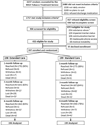Sustained care intervention and postdischarge smoking cessation among hospitalized adults: a randomized clinical trial
- PMID: 25138333
- PMCID: PMC4507269
- DOI: 10.1001/jama.2014.9237
Sustained care intervention and postdischarge smoking cessation among hospitalized adults: a randomized clinical trial
Abstract
Importance: Health care systems need effective models to manage chronic diseases like tobacco dependence across transitions in care. Hospitalizations provide opportunities for smokers to quit, but research suggests that hospital-delivered interventions are effective only if treatment continues after discharge.
Objective: To determine whether an intervention to sustain tobacco treatment after hospital discharge increases smoking cessation rates compared with standard care.
Design, setting, and participants: A randomized clinical trial compared sustained care (a postdischarge tobacco cessation intervention) with standard care among 397 hospitalized daily smokers (mean age, 53 years; 48% were males; 81% were non-Hispanic whites) who wanted to quit smoking after discharge and received a tobacco dependence intervention in the hospital; 92% of eligible patients and 44% of screened patients enrolled. The study was conducted from August 2010 through November 2012 at Massachusetts General Hospital.
Interventions: Sustained care participants received automated interactive voice response telephone calls and their choice of free smoking cessation medication (any type approved by the US Food and Drug Administration) for up to 90 days. The automated telephone calls promoted cessation, provided medication management, and triaged smokers for additional counseling. Standard care participants received recommendations for postdischarge pharmacotherapy and counseling.
Main outcomes and measures: The primary outcome was biochemically confirmed past 7-day tobacco abstinence at 6-month follow-up after discharge from the hospital; secondary outcomes included self-reported tobacco abstinence.
Results: Smokers randomly assigned to sustained care (n = 198) used more counseling and more pharmacotherapy at each follow-up assessment than those assigned to standard care (n = 199). Biochemically validated 7-day tobacco abstinence at 6 months was higher with sustained care (26%) than with standard care (15%) (relative risk [RR], 1.71 [95% CI, 1.14-2.56], P = .009; number needed to treat, 9.4 [95% CI, 5.4-35.5]). Using multiple imputation for missing outcomes, the RR for 7-day tobacco abstinence was 1.55 (95% CI, 1.03-2.21; P = .04). Sustained care also resulted in higher self-reported continuous abstinence rates for 6 months after discharge (27% vs 16% for standard care; RR, 1.70 [95% CI, 1.15-2.51]; P = .007).
Conclusions and relevance: Among hospitalized adult smokers who wanted to quit smoking, a postdischarge intervention providing automated telephone calls and free medication resulted in higher rates of smoking cessation at 6 months compared with a standard recommendation to use counseling and medication after discharge. These findings, if replicated, suggest an approach to help achieve sustained smoking cessation after a hospital stay.
Trial registration: clinicaltrials.gov Identifier: NCT01177176.
Conflict of interest statement
Dr. Rigotti has been an unpaid consultant for Pfizer, Inc and Alere Wellbeing, Inc., regarding smoking cessation and receives royalties from UpToDate for reviews on smoking cessation. Pfizer paid for Dr. Rigotti’s travel expenses to attend a consultant meeting for which she received no honorarium. Dr. Park has a grant from Pfizer to provide free varenicline for use in a trial funded by NCI. Dr. Levy has been a paid consultant to CVS, Inc., to provide expertise on tobacco policy. Dr. Singer has been a paid consultant for Pfizer, Inc., but on matters separate from smoking cessation. No other authors have any conflicts of interest to disclose.
Figures


References
-
- U.S. Department of Health and Human Services. The Health Consequences of Smoking—50 Years of Progress: A Report of the Surgeon General. Atlanta, GA: U.S. Department of Health and Human Services, Centers for Disease Control and Prevention, National Center for Chronic Disease Prevention and Health Promotion, Office on Smoking and Health; 2014. [Accessed 1/18/14]. http://www.surgeongeneral.gov/library/reports/50-years-of-progress/index....
-
- Fiore MC, Jaén CR, Baker TB, et al. Treating Tobacco Use and Dependence: 2008 Update. Clinical Practice Guideline. Rockville, MD: U.S. Department of Health and Human Services. Public Health Service; 2008. May,
-
- Rigotti NA, Clair C, Munafo MR, Stead LF. Interventions for smoking cessation in hospitalised patients. [Accessed February 20, 2014];Cochrane Database of Systematic Reviews. 2012 (5) Available from EBM Reviews - Cochrane Database of Systematic Reviews at http://ovidsp.ovid.com/ovidweb.cgi?T=JS&PAGE=reference&D=coch&NEWS=N&AN=.... - PMC - PubMed
-
- National Quality Forum. [Accessed March 10, 2014];NQF endorses behavioral health measures. 2014 Mar 7; http://www.qualityforum.org/News_And_Resources/Press_Releases/2014/NQF_E....
Publication types
MeSH terms
Associated data
Grants and funding
LinkOut - more resources
Full Text Sources
Other Literature Sources
Medical
Miscellaneous

